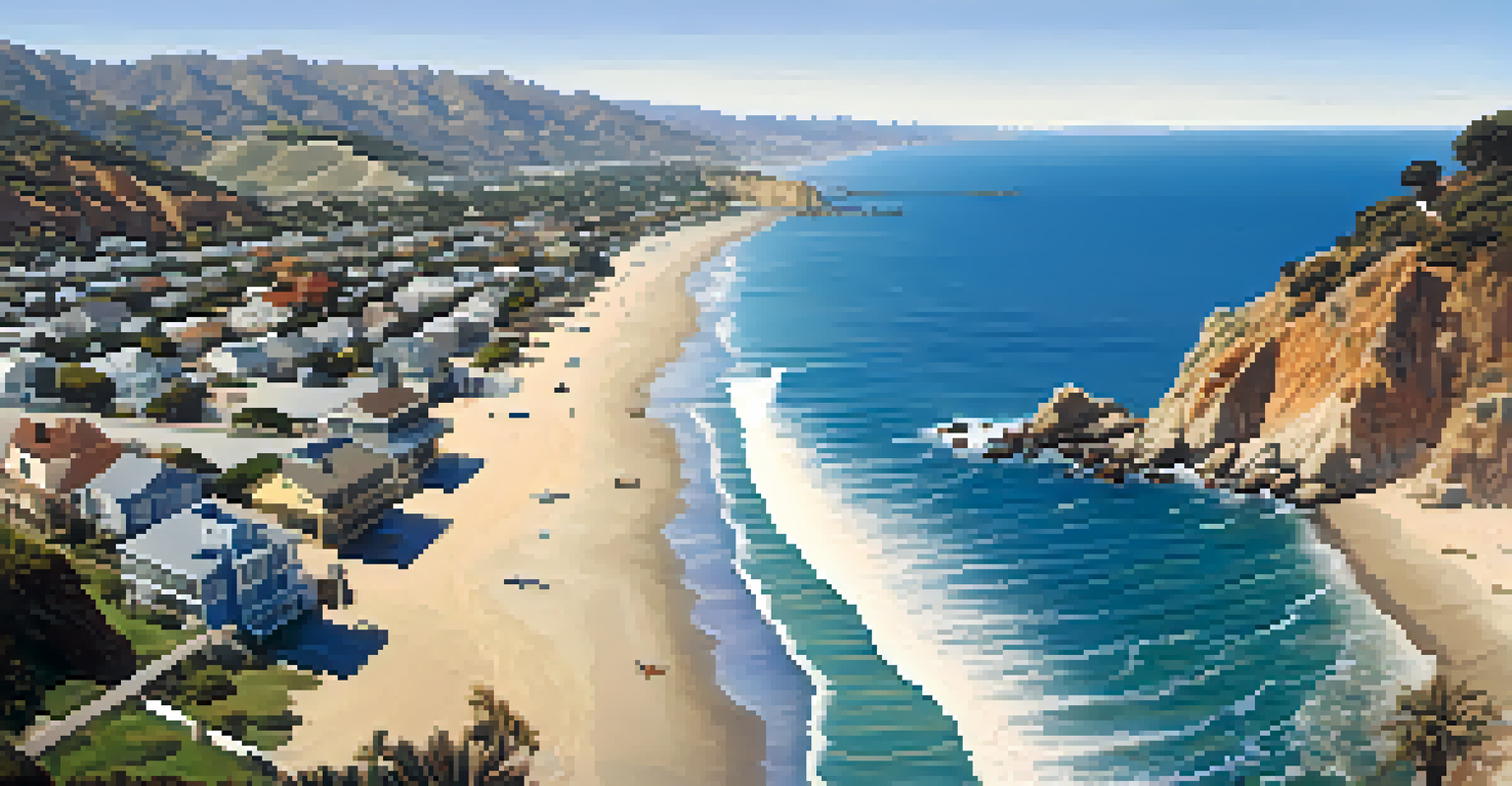Role of Development in Malibu's Coastal Erosion Problems

Understanding Coastal Erosion in Malibu
Coastal erosion is a natural process where shorelines are worn away by waves, currents, and tides. In Malibu, this phenomenon is particularly pronounced due to its unique geography and climate. The stunning cliffs and beaches are not just beautiful; they are also vulnerable to erosion, especially under the impact of human activities.
The coast is a dynamic environment, and we must adapt our development strategies to protect it from the forces of nature.
As the environment changes, Malibu's coastlines face increased vulnerability, leading to loss of land and natural habitats. Erosion can result from various factors, including storms, rising sea levels, and human interference. Understanding these elements is crucial for addressing the ongoing challenges Malibu faces.
The picturesque landscape, while alluring, hides the ongoing battle between nature and development. With the increasing intensity of storms and rising ocean levels, Malibu must confront the reality of its changing coastline and the role development plays in the equation.
The Role of Development in Coastal Dynamics
Development along the coast can significantly alter the natural dynamics of erosion. When buildings, roads, and other infrastructure are constructed too close to the shoreline, they can disrupt natural sediment flow and water movement. These changes can exacerbate erosion, leading to quicker land loss than what would occur naturally.

For instance, the construction of seawalls and jetties, intended to protect property, can often lead to unintended consequences. While they might shield certain areas, they can accelerate erosion in adjacent locations, creating a cycle of damage. This highlights the need for a balanced approach to coastal development.
Coastal Erosion Threatens Malibu
Malibu's coastlines are increasingly vulnerable to erosion driven by natural forces and human activities.
Understanding the interplay between development and erosion is crucial for future planning. Responsible development should account for the natural processes at work, ensuring that protective measures do not inadvertently create new problems for the coastline.
Impact of Urbanization on Malibu's Coast
Urbanization dramatically changes the landscape, often at the cost of natural ecosystems. In Malibu, increased population density and housing developments have led to the removal of vegetation that would naturally protect the coastline. The absence of these plants can lead to more significant erosion and destabilization of the soil.
Sustainable development is about balancing the needs of the present without compromising the ability of future generations to meet their own needs.
Additionally, the increased runoff from paved surfaces and buildings can contribute to erosion as well. Water that would normally be absorbed by the ground now flows freely into the ocean, carrying away sand and soil. This not only impacts the immediate area but can also have far-reaching effects on the coastal ecosystem.
As Malibu continues to grow, the challenge lies in balancing development with environmental preservation. Finding sustainable solutions that protect both the community and the coastline is essential for the future of Malibu’s beautiful shores.
Historical Context of Development in Malibu
Malibu has a rich history of development that has shaped its coastal landscape. Originally a quiet beach community, it has transformed into a coveted area for luxury homes and resorts. This rapid development has brought economic benefits but has also come with environmental costs, particularly concerning erosion.
Historically, many homeowners built right on the beach, often ignoring the long-term implications of their choices. As the coastline continues to recede, these decisions have become increasingly problematic, highlighting the need for historical awareness in future planning efforts.
Development Impacts Coastal Health
Urbanization and coastal development disrupt natural processes, leading to accelerated erosion and habitat loss.
Learning from the past can guide Malibu toward more sustainable development practices. By reflecting on the historical context, stakeholders can work together to create plans that prioritize the preservation of the coastline while still accommodating growth.
Community Response to Erosion Challenges
The local community in Malibu has been increasingly vocal about the challenges posed by coastal erosion. Awareness campaigns and community meetings have helped residents understand the implications of development on their environment. This grassroots involvement is crucial in advocating for sustainable practices and policies.
Residents have started to push for measures such as beach nourishment, which involves adding sand to the beach to counteract erosion. These initiatives not only protect the shoreline but also foster a sense of community and connection to the natural landscape. Collaborative efforts can lead to stronger, more resilient coastal defenses.
Community engagement is essential for driving change in Malibu. When residents come together to address these issues, they can influence policy decisions and ensure that future developments prioritize ecological balance alongside economic growth.
Regulatory Measures and Policies in Place
Regulatory measures are vital in managing coastal development and mitigating erosion. In Malibu, various policies are designed to protect the coastline, including zoning laws that restrict building near the water’s edge. These regulations aim to balance development needs with environmental protection.
Furthermore, the California Coastal Commission plays a key role in overseeing coastal development projects. They assess the potential impact on erosion and overall coastal health before granting permits. This regulatory framework is essential for ensuring that new developments do not exacerbate existing erosion issues.
Community Engagement is Crucial
Local residents play a vital role in advocating for sustainable practices to combat the challenges of coastal erosion.
While regulations exist, ongoing evaluation and adaptation are necessary. As environmental conditions change, so too must the policies that govern development. This flexibility will ensure that Malibu remains a beautiful and sustainable coastal community.
Future Considerations for Malibu's Development
Looking ahead, Malibu faces significant challenges regarding development and coastal erosion. The reality of climate change, with its rising sea levels and increased storm intensity, requires proactive planning. Developers, residents, and policymakers must work together to create resilient strategies that protect the coastline.
Innovative solutions, such as green infrastructure and sustainable building practices, can help mitigate the impacts of development on erosion. For example, incorporating natural barriers like dunes or vegetation can provide both protection and aesthetic value. Emphasizing these approaches can lead to a healthier balance between development and the environment.

The future of Malibu’s coast depends on thoughtful consideration of both development and environmental needs. By fostering collaboration and prioritizing sustainability, Malibu can navigate the complexities of coastal erosion while preserving its cherished landscapes for generations to come.